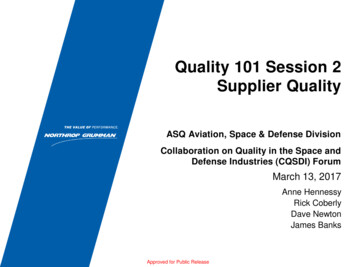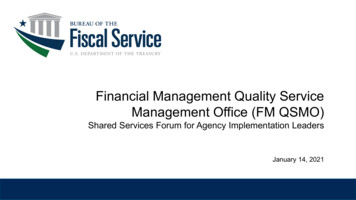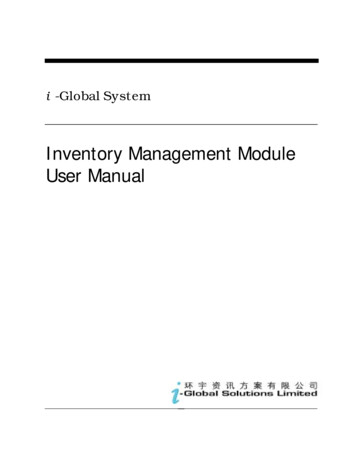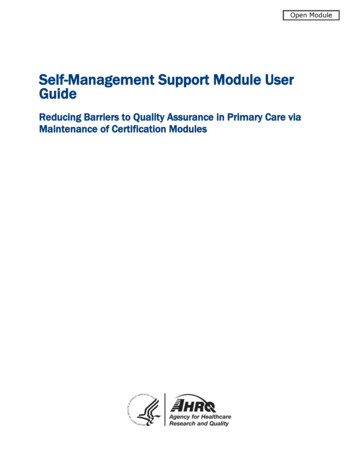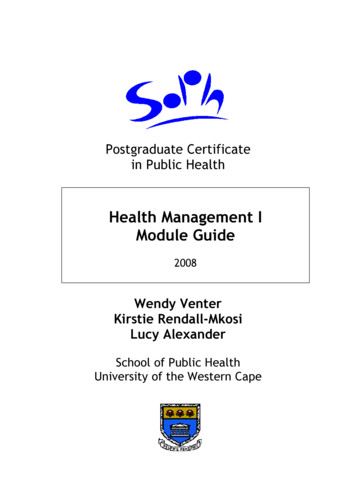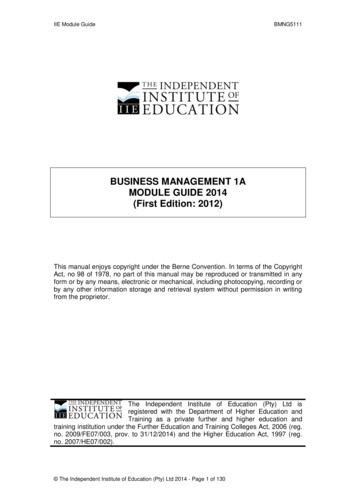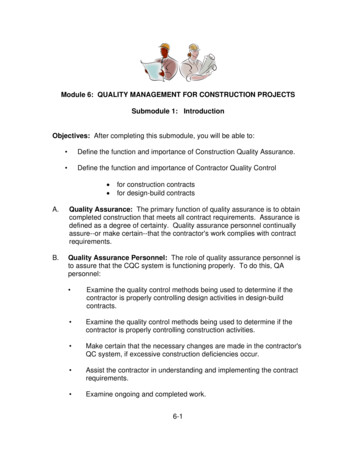
Transcription
Module 6: QUALITY MANAGEMENT FOR CONSTRUCTION PROJECTSSubmodule 1: IntroductionObjectives: After completing this submodule, you will be able to: Define the function and importance of Construction Quality Assurance. Define the function and importance of Contractor Quality Control for construction contractsfor design-build contractsA.Quality Assurance: The primary function of quality assurance is to obtaincompleted construction that meets all contract requirements. Assurance isdefined as a degree of certainty. Quality assurance personnel continuallyassure--or make certain--that the contractor's work complies with contractrequirements.B.Quality Assurance Personnel: The role of quality assurance personnel isto assure that the CQC system is functioning properly. To do this, QApersonnel: Examine the quality control methods being used to determine if thecontractor is properly controlling design activities in design-buildcontracts. Examine the quality control methods being used to determine if thecontractor is properly controlling construction activities. Make certain that the necessary changes are made in the contractor'sQC system, if excessive construction deficiencies occur. Assist the contractor in understanding and implementing the contractrequirements. Examine ongoing and completed work.6-1
Review QC documentation to assure adequacy.C.Contractor Quality Control: The primary function of CQC is thesuccessful execution of a realistic plan to ensure that the requiredstandards of quality construction will be met. In CQC, the contractordefines procedures to manage and control his own, designer of record,consultant, architect-engineer, all subcontractor and all supplier activities sothat the completed project complies with contract requirements. Fordesign-build contracts this includes providing and maintaining a DesignQuality Control plan as a part of the overall contract QC plan. This plan, asa minimum, must assure that all documents are reviewed by a technicallycompetent, independent reviewer specifically named in the plan. Thisreview cannot be performed by the same designers that produced theproduct. The design QC plan shall be managed by a Design QC Managerwho has verifiable engineering or architectural design experience or is aregistered engineer or architect. The Design QC Manager is under thesupervision of the QC Manager.D.Quality Control Personnel: As stated previously, CQC is a contractorresponsibility. This includes: Produce the quality specified in the plans and specifications, and fordesign-build contracts in the Request for Proposal, as well as thecontractor's accepted proposal, Develop and maintain an effective CQC system, Perform all control activities and tests, and Prepare acceptable documentation of CQC activities.The contractor also is required to place a competent representative onsiteto oversee the CQC system. He must have full authority to act for thecontractor on CQC matters. His responsibilities include workmanship,methods, and techniques to ensure that all work is performed properly byqualified and careful craftsmen. For design-build contracts, responsibilityalso includes design quality and the performance of constructibility,operability and environmental review of the design.6-2
EXERCISESubmodule 6.11.What is the primary function of QA?2.What is the role of QA personnel?3.What is the primary function of CQC?4.What are the roles of QC personnel?6-3
5.For design-build contracts what additional requirements must be included inthe QC plan?6-4
NOTESCONSTRUCTION QUALITY MANAGEMENTFOR CONTRACTORS6-5
NOTESCONSTRUCTION QUALITY MANAGEMENTFOR CONTRACTORS6-6
Module 6: QUALITY MANAGEMENT FOR CONSTRUCTION PROJECTSSubmodule 2:Three-Phase Control SystemObjectives: After completing this submodule, you will be able to:A. Define the purpose of control of onsite construction through theThree-Phase Control System. List the responsibilities of QC personnel regarding the three-phasecontrol system.Purpose:The primary purpose of the Three-Phase Control System is to require thecontractor to plan and schedule the work to ensure that he is prepared tostart each new definable feature of work. The three phases of control(preparatory, initial, and follow-up) are the core of the ConstructionQuality Management System. When they are performed as outlined inthe specifications, success in completing the work to comply withrequirements of the contract is enhanced. In Module 3, Submodule 1,the three-phase control system was mentioned as a required part of thecontractor's quality control plan.B.Three-Phase Control Responsibility: Develop, schedule and implement procedures for tracking controlphase meetings for definable features of work in the QC Plan. Notify appropriate personnel of time, date and agenda. Conduct Meetings (preparatory and initial). Safety considerations and Activity Hazard Analyses (AHAs). Document actual discussions and provide minutes to attendees.6-7
C. Monitor work in place through follow-up phase. Conduct additional control phase meetings, as needed.The Three-Phase Control System:1.Preparatory Phase: This phase shall be performed prior to beginningwork on each definable feature of work. Perform this work as detailedbelow:-A review of each paragraph of applicable specifications andreferences.-A review of contract plans.-A check to assure that all materials and/or equipment have beentested, submitted, and approved.-A check to assure that provisions have been made to providerequired control inspection and testing.-Examination of the work area to assure that all requiredpreliminary work has been completed.-A physical examination of required materials, equipment, andsample work to assure that they are on hand and conform toapproved shop drawings or submitted data.-A review of the appropriate activity hazard analysis.-Discussion of procedures for constructing the work including thereview of repetitive deficiencies. The Government shall be notified in advance of beginning any of therequired action of the preparatory phase as required in the QCspecifications. This phase shall include a meeting conducted by the QC Manager andattended by the superintendent, other CQC personnel (as applicable),and the foremen responsible for the definable feature. The results ofthe preparatory phase actions shall be documented by separateminutes prepared by the QC Manager and attached to the daily CQCreport.6-8
2.3.D.Initial Phase: This phase must be accomplished at the beginning of adefinable feature of work. The “Initial Phase” will verify that control forthe work developed in the “Preparatory Meeting” is implemented andthe work is performed to the level of workmanship mutually agreed to.Perform this work as detailed below:-Review minutes of Preparatory Meeting.-Check preliminary work.-Verify adequacy of controls to ensure full contractcompliance.-Establish level of workmanship.-Resolve all differences.-Check safety to include compliance with the safety plan andactivity hazard analysis. Review the activity hazard analysiswith workers. The Government shall be notified in advance of the beginning ofthe Initial Phase as required in the CQC specifications. The QC Manager is in charge of the Initial Phase Meeting.Separate minutes of this phase shall be prepared by the QCManager and attached to the daily CQC report. The initial phaseshall be repeated for each new crew to work onsite, or any timeestablished level of workmanship is not being met.Follow-up Phase: Daily checks shall be performed to assurecontinuing compliance with contract requirements, including safetyand control testing, until completion of the particular feature of work.The checks shall be made a matter of record in the CQCdocumentation. Final follow-up checks shall be conducted and alldeficiencies corrected prior to the start of additional features of work.QC personnel should continually refer back to the standards set in the“Preparatory and Initial Phases.”Cautionary Note: QC personnel, in the midst of day-to-day duties, caneasily fall into the trap of only working to detect deficiencies when in facttheir role is to prevent deficiencies.6-9
3 Phases of ControlUsing a simplified ScheduleOCTNOVDE CJA NClear & GrubE x cavationConc rete FoundationCM U W allsRoofingE lec tricalM ehanicalFinish W orkP reparatory P has eInitial P haseFollow-up P has eFigure 16-10FE BMARAPRMAYJUN
3 Phases - What is involved?Preparatory Phase:Review Plans and SpecsVerify submittal approvalReview test planCheck preliminary workExamine materialsDiscuss construction methodsReview SafetyCMU WallsInitial Phase:Follow-up Phase:Establish quality requiredResolve conflictsEnsure testing is performedReview SafetyEnsure contract complianceMaintain qualityEnsure testing report is submittedEnsure rework is completedFigure 23 Phases - Who is involved?Preparatory Phase:QC ManagerQC SpecialistsSuperintendentSubcontractor ForemanQA RepresentativeCMU WallsInitial Phase:Follow-up Phase:QC ManagerQC SpecialistsSuperintendentSubcontractor ForemanQA RepresentativeQC ManagerQC SpecialistSuperintendentSubcontractor ForemanQA RepresentativeFigure 36-11
EXERCISESubmodule 6.21.What is the primary purpose of the three-phase control system?2.Regarding the three-phase control system, what are the responsibilities ofquality control personnel?6-12
PRACTICAL EXERCISESubmodule 6.2PREPARATORY PHASE MEETING EXERCISEYou are involved in the construction of a 22,000,000 two-bay hanger at MarchAir Force Base in California. Included in the project is 2,000 feet of 24-inchdiameter storm drainage pipe. Manholes are to be installed every 300 feet.Storm drainage pipe is listed in the Quality Control Plan as a definable feature ofwork. The contractor plans to use reinforced concrete pipe and pre-castmanholes.SCOPE: Install 2,000 feet of 24-inch storm drainage pipe. Pre-cast manholesshall be installed every 300 feet.Task: Prepare to attend preparatory meeting to begin the work. Use thechecklist included as a guide.Assumptions:You are:Pipe is on siteSubmittals are approvedExcavation permit is issuedSafety plan covers the work and is satisfactoryLayout work is completeResident Engineer or ROICC/SGEProject Engineer or AROICC/AREICCOnsite Quality Assurance PersonTEAM 16-13
PRACTICAL EXERCISESubmodule 6.2PREPARATORY PHASE MEETING EXERCISEYou are involved in the construction of a 22,000,000 two-bay hanger at MarchAir Force Base in California. Included in the project is 2,000 feet of 24-inchdiameter storm drainage pipe. Manholes are to be installed every 300 feet.Storm drainage pipe is listed in the Quality Control Plan as a definable feature ofwork. The contractor plans to use reinforced concrete pipe and pre-castmanholes.SCOPE: Install 2,000 feet of 24-inch storm drainage pipe. Pre-cast manholesshall be installed every 300 feet.Task: Perform preparatory meeting to begin the work. Use the checklistincluded as a guide.Assumptions:You are:Pipe is on siteSubmittals are approvedExcavation permit is issuedSafety plan covers the work and is satisfactoryLayout work is completeProject SuperintendentQuality Control ManagerSite Work Subcontractor's SuperintendentStorm Drainage System Second Tier Subcontractor's ForemanSafety EngineerTEAM 26-14
SAMPLEPreparatory Phase ChecklistContract No.:Date:Definable Feature:Government Rep NotifiedSpec Section:Hours in AdvanceYes NoI. Personnel 7.(List additional personnel on reverse side)II. Submittals1.Review submittals and/or submittal log 4288. Have all submittals been approved?Yes NoIf No, what items have not been submitted?a.b.c.2. Are all materials on hand? Yes NoIf No, what items are missing?a.b.c.3. Check approved submittals against delivered material. (This should be done as materialarrives.)Comments6-15
III. Material storageAre materials stored properly? Yes NoIf No, what action is taken?IV. Specifications1. Review each paragraph of specifications.2. Discuss procedure for accomplishing the work.3. Clarify any differences.V. Preliminary Work and PermitsEnsure preliminary work is correct and permits are on file.If not, what action is taken?VI. Testing1. Identify test to be performed, frequency, and by whom.2. When required?3. Where required?4. Review Testing Plan.5. Has test facilities been approved?VII. Safety1. Review applicable portion of EM 385-1-1.2. Activity Hazard Analysis approved? Yes NoVIII. Corps of Engineers comments during meeting.QC Manager6-16
NOTESCONSTRUCTION QUALITY MANAGEMENTFOR CONTRACTORS6-17
NOTESCONSTRUCTION QUALITY MANAGEMENTFOR CONTRACTORS6-18
Module 6: QUALITY MANAGEMENT FOR CONSTRUCTION PROJECTSSubmodule 3: DocumentationObjectives: After completing this submodule, you will be able to:A. Explain the purpose and importance of the Contractor Quality Control(CQC) Report. List the components of the CQC Report. Explain the purpose and importance of the Government QualityAssurance (QA) Report. Discuss the review and use of quality management reports.Quality Management Record Keeping:A comprehensive record keeping and information exchange system is anindispensable quality management tool. In addition to identifying specificdeficiencies, careful report analysis will also detect patterns in the team'sperformance. If these patterns are detrimental, early detection andcorrection will save time, effort, and money for both the Government andthe contractor.B.The Contractor Quality Control Report: The requirement for the contractor to submit daily QC reports isestablished in the QC specification. As discussed previously, theCoordination Meeting or the Mutual Understanding Meeting (Navy)should include a detailed discussion of reporting procedures,information required in the reports, and the importance of the reports.The QC Report is to be submitted at a prescribed time every day, andall information relating to QC activities is to be inc
Module 6: QUALITY MANAGEMENT FOR CONSTRUCTION PROJECTS Submodule 1: Introduction Objectives: After completing this submodule, you will be able to: Define the function and importance of Construction Quality Assurance. Define the function and importance of Contractor Quality Control for construction contractsFile Size: 320KBPage Count: 39




